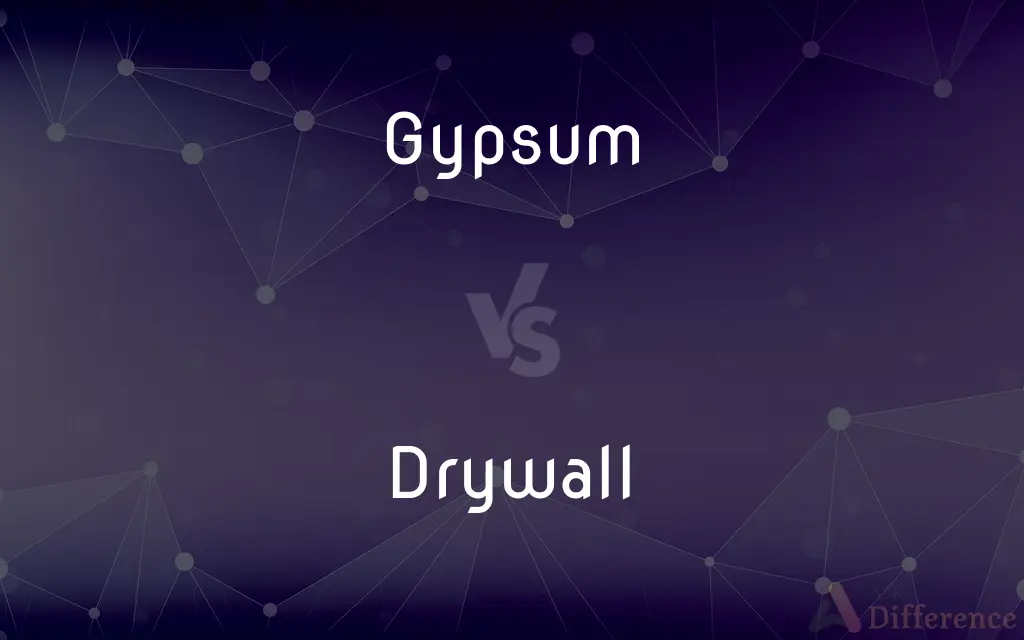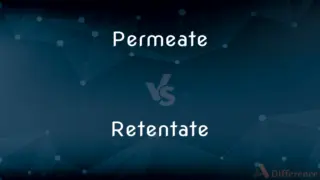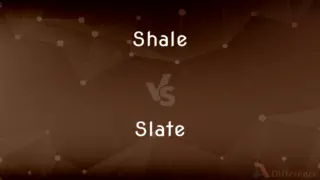Gypsum vs. Drywall — What's the Difference?
By Tayyaba Rehman — Updated on October 13, 2023
Gypsum is a mineral used in various industrial applications, notably in drywall manufacture, while drywall is a construction material made from gypsum board, used to create walls and ceilings.

Difference Between Gypsum and Drywall
Table of Contents
ADVERTISEMENT
Key Differences
Gypsum, a naturally occurring mineral, is widely utilized for a multitude of applications in construction, agriculture, and other industries. Drywall, conversely, is a specific construction material composed of gypsum board and is primarily used to form interior walls and ceilings. While gypsum has an expansive array of uses, drywall is singularly purposed and embodies only one application of gypsum.
The versatility of gypsum spans beyond the realm of drywall, considering its role in creating plaster, cement, and even certain products in the agricultural sector. Drywall, while a crucial component in modern construction, provides a stark contrast in its utilization, being bound by its structural application. Gypsum’s inherent fire-resistant and insulating properties are what make it valuable in various domains, whereas drywall specifically harnesses these properties for building construction.
Gypsum, in its raw form, is a mineral that is mined from the earth, encompassing characteristics like being soft and hydratable. Drywall takes gypsum, processes it into a powder, and then reforms it into board sheets, offering a practical, fire-resistant material for constructing interior walls. Gypsum’s manifestation as a raw material offers broad potentials, while drywall distinctly offers a readied solution for specific construction needs.
The extraction and processing of gypsum provide the foundational material used in drywall production, signifying a root and product relationship between the two. Drywall, while containing gypsum, also incorporates other materials, such as paper lining, to create the final product used in construction. Gypsum’s utility is not confined to construction alone, whereas drywall is meticulously designed for it.
It’s pivotal to highlight that gypsum’s existence and utility in various industries is vast and multifaceted. In contrast, drywall is a pivotal, yet singular application of gypsum, ingeniously designed to meet the demands of modern construction. Thus, gypsum is foundational, while drywall is a derivative product that employs gypsum’s beneficial properties in a specific context.
ADVERTISEMENT
Comparison Chart
Definition
A soft sulfate mineral.
A construction material.
Primary Use
Varied (construction, etc.)
Interior walls/ceilings.
Form
Natural mineral.
Manufactured board.
Applications
Diverse (plaster, cement, etc.)
Singular (construction).
Dependence
Independent material.
Depends on gypsum.
Compare with Definitions
Gypsum
A component in making cement.
Gypsum is added to clinker in cement production.
Drywall
Known for quick installation and finishing.
The contractor chose drywall to save on installation time.
Gypsum
A sulfate mineral consisting of calcium sulfate dihydrate.
The mineral gypsum is soft and can be easily powdered.
Drywall
A fire-resistant construction material.
Drywall provides a certain degree of fire resistance.
Gypsum
A widely used mineral in construction and industry.
Gypsum is utilized in making drywall and plaster.
Drywall
Can be used as a base for wall finishes.
The painter applied a primer to the drywall.
Gypsum
Used in agriculture to improve soil composition.
Farmers often use gypsum to condition the soil.
Drywall
Used to construct interior walls and ceilings.
The building's interior walls were made of drywall.
Gypsum
Gypsum is a soft sulfate mineral composed of calcium sulfate dihydrate, with the chemical formula CaSO4·2H2O. It is widely mined and is used as a fertilizer and as the main constituent in many forms of plaster, blackboard/sidewalk chalk, and drywall. A massive fine-grained white or lightly tinted variety of gypsum, called alabaster, has been used for sculpture by many cultures including Ancient Egypt, Mesopotamia, Ancient Rome, the Byzantine Empire, and the Nottingham alabasters of Medieval England.
Drywall
A building material comprising gypsum board.
Drywall is preferred for its ease in construction.
Gypsum
A widespread colorless, white, or yellowish mineral, CaSO4·2H2O, used in the manufacture of plaster of Paris, various plaster products, and fertilizers.
Drywall
Drywall (also known as plasterboard, wallboard, sheet rock, gypsum board, buster board, custard board, or gypsum panel) is a panel made of calcium sulfate dihydrate (gypsum), with or without additives, typically extruded between thick sheets of facer and backer paper, used in the construction of interior walls and ceilings. The plaster is mixed with fiber (typically paper, glass wool, or a combination of these materials), plasticizer, foaming agent, and various additives that can reduce mildew, flammability, and water absorption.
Gypsum
A mineral consisting of hydrated calcium sulphate. When calcinated, it forms plaster of Paris.
Drywall
Plasterboard
Drywall partitions
Gypsum
A mineral consisting of the hydrous sulphate of lime (calcium). When calcined, it forms plaster of Paris. Selenite is a transparent, crystalline variety; alabaster, a fine, white, massive variety.
Drywall
A building material consisting of rectangular sections usually made of a gypsum plaster core bonded between layers of heavy paper, used especially in the construction of interior walls and ceilings. Also called gypsum board, plasterboard, wallboard.
Gypsum
A common white or colorless mineral (hydrated calcium sulphate) used to make cements and plasters (especially plaster of Paris)
Drywall
Also dry wall A wall constructed from rocks that are not cemented together.
Gypsum
A fire-resistant material.
Gypsum’s fire-resistant property makes it valuable in construction.
Drywall
To construct (a wall or ceiling) using drywall.
Drywall
To construct a wall or ceiling in (a room or building) using drywall.
Drywall
A building material comprising a sheet of gypsum sandwiched between two pieces of heavy paper, used mainly for interior walls and ceilings.
Drywall
A wall made of this.
Drywall
A stone wall constructed without mortar or cement.
Drywall
(ambitransitive) To install and finish drywall.
Common Curiosities
What is drywall’s main component?
Drywall is primarily made from gypsum board.
Can drywall be used externally?
Typically, no, as drywall is not resistant to moisture and weather conditions.
Can drywall resist fire?
Yes, the gypsum in drywall is fire-resistant, slowing the spread of flames.
What is gypsum primarily used for?
Gypsum is widely used for making drywall, plaster, and cement.
Is gypsum fire-resistant?
Yes, gypsum is inherently fire-resistant, making it valuable in construction.
Can gypsum be used in making plaster?
Yes, gypsum is commonly used to make plaster.
Is gypsum used in agriculture?
Yes, gypsum can be used to improve and condition soil in agriculture.
Does drywall come in different thicknesses?
Yes, drywall is available in various thicknesses, commonly 1/2" and 5/8".
Is installing drywall a quick process?
Yes, drywall is known for its relatively quick and easy installation.
Can gypsum be found naturally?
Yes, gypsum is a naturally occurring mineral mined from the earth.
Can drywall be recycled?
Yes, drywall can be recycled and used to manufacture new gypsum board.
How hard is gypsum?
Gypsum is relatively soft and can be scratched with a fingernail.
Is gypsum always white in color?
Mostly, yes, but it can have color impurities like red or brown due to iron oxide.
How is drywall finished?
Drywall is finished with joint compound and tape, then typically painted.
Are gypsum and drywall the same?
No, gypsum is a mineral used in various applications, while drywall is a construction material made from gypsum board.
Share Your Discovery

Previous Comparison
Permeate vs. Retentate
Next Comparison
Shale vs. SlateAuthor Spotlight
Written by
Tayyaba RehmanTayyaba Rehman is a distinguished writer, currently serving as a primary contributor to askdifference.com. As a researcher in semantics and etymology, Tayyaba's passion for the complexity of languages and their distinctions has found a perfect home on the platform. Tayyaba delves into the intricacies of language, distinguishing between commonly confused words and phrases, thereby providing clarity for readers worldwide.














































